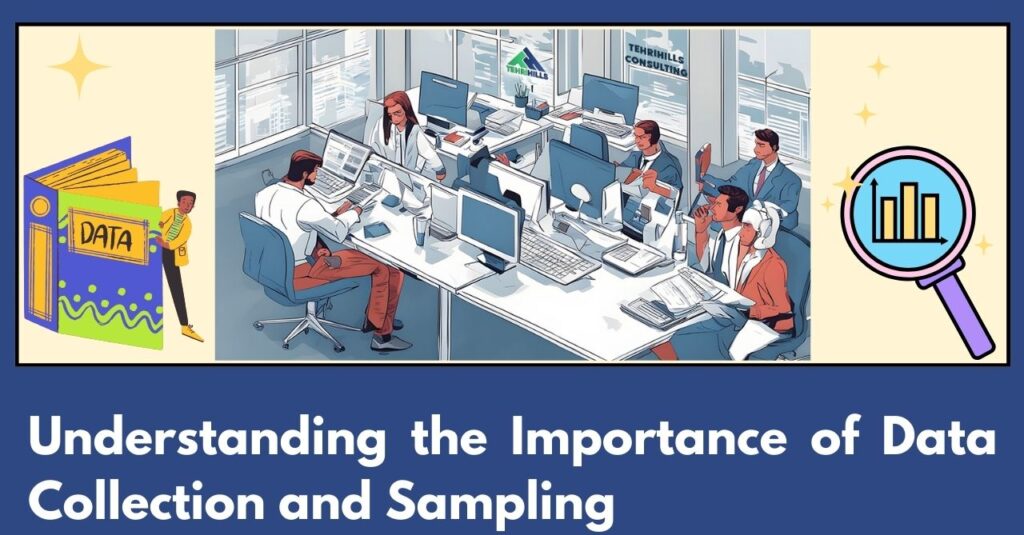Introduction
Sampling is a fundamental aspect of market research, allowing researchers to gain insights into a larger population without having to study each individual within it. At Tehrihills Consulting, we understand the critical role of sampling in facilitating accurate and actionable Market Data Analysis. Our approach integrates advanced techniques to ensure the representativeness and reliability of the data collected in global market research.
Imagine a scenario where a company aims to understand consumer preferences across different demographics for a new product launch. Conducting surveys or studies with the entire population would be impractical and costly. Instead, through strategic sampling, we can select representative samples from each demographic group and analyze their preferences, behaviors, and opinions. This approach not only streamlines the research process but also provides valuable insights that drive informed decision-making.
Sampling is not just about selecting a subset of the population; it’s about strategically choosing the right sample to represent the entire population accurately. By leveraging advanced sampling techniques and cutting-edge research methodologies, Tehrihills Consulting ensures that our clients receive accurate, reliable, and actionable insights to fuel their business growth through global data collection and analysis.
Types of sampling : Sampling methods
- Probability Sampling Methods: Researcher employ specific criteria to randomly select members from a population. Each member within the population has an equal chance of being chosen for inclusion in the sample, ensuring fairness and representativeness. This systematic approach allows Tehrihills Consulting to gather diverse insights from various segments of the target population, driving robust market research and data analysis outcomes.
- Simple Random Sampling: Simple random sampling involves selecting elements from a population entirely at random, ensuring each member has an equal chance of being chosen. This method, akin to picking a name out of a hat, offers an unbiased approach to sample selection. For instance, in an organization of 300 employees, each individual has an equal opportunity of being selected for a sample, facilitating comprehensive insights for Tehrihills Consulting’s market research initiatives.
- Systematic Sampling: Systematic sampling entails selecting elements at regular intervals from a population after an initial random selection. This method offers flexibility in sample selection intervals, allowing researchers to avoid unintentional clustering. For example, a researcher may choose every 10th individual from a population of 7000 to form a systematic sample, optimizing time and resources for data collection endeavors in global data collection and analysis.
- Stratified Sampling: Stratified sampling involves dividing a population into distinct groups based on predefined criteria and then selecting samples randomly from each group. This method enables researchers to obtain representative samples from diverse segments of the population. For instance, Tehrihills Consulting may stratify a population based on income levels to analyze consumer behaviors across various income brackets, thereby enhancing the efficacy of Market Data Analysis.
- Cluster Sampling: Cluster sampling entails selecting entire groups or clusters from a population rather than individual units. These clusters, such as geographic regions or academic cohorts, are randomly chosen to represent the entire population. By organizing clusters based on demographic parameters, Tehrihills Consulting can derive actionable insights from diverse population segments, facilitating targeted marketing strategies and informed decision-making in global market research.
2. Non-Probability Sampling Methods: The researcher researchers handpick sample participants according to the specific objectives of their research goals. Unlike probability-based approaches, this method lacks a rigid or predetermined selection process, resulting in varying opportunities for different elements of the population to be part of the sample. This flexible methodology enables Tehrihills Consulting to tailor sampling techniques to meet the unique requirements of each research project, ensuring comprehensive and targeted insights for our clients.
- Convenience Sampling: Convenience sampling involves selecting samples based on their accessibility and proximity to the researcher. While convenient, this method may introduce bias due to its non-random nature. However, it serves as a pragmatic approach in situations with time and resource constraints, allowing Tehrihills Consulting to gather preliminary insights swiftly.
- Quota Sampling: Quota sampling involves setting predetermined quotas for sample attributes, such as gender or age, to ensure representation across target demographics. While quota sampling facilitates demographic diversity in samples, Tehrihills Consulting acknowledges the potential for bias in sample selection and strives to mitigate it through rigorous market research and data analysis methodologies.
- Purposive Sampling: Purposive sampling entails selecting samples based on the researcher’s judgment and expertise, focusing on specific characteristics relevant to the research objectives. While purposive sampling may not yield representative samples, it offers a quick and efficient means of obtaining insights tailored to client’s market research needs.
- Snowball Sampling: Snowball sampling involves recruiting participants through referrals from existing sample members, cascading through interconnected networks like a snowball rolling downhill. This method proves invaluable in reaching elusive populations or addressing sensitive topics, ensuring Tehrihills Consulting’s research initiatives encompass diverse perspectives.

Conclusion –
In conclusion, sampling methods serve as the bedrock of market research, enabling Tehrihills Consulting to gather comprehensive data for Global data collection and analysis and Market Data Analysis. By employing a diverse array of sampling techniques, we ensure the accuracy, reliability, and relevance of insights that drive our clients’ success. Partner with Tehrihills Consulting for unparalleled market research solutions tailored to your business objectives.
Unlock the power of Market Data Analysis with Tehrihills Consulting – your trusted partner for Market Research and Data Analysis. Explore global data collection and analysis, Conjoint Data Analysis, Decipher survey programming, CATI Market Research & MaxDiff Analysis. Trust Tehrihills Consulting for accurate Global Market Research Analytics, and expert Data Validation. Partner with us for comprehensive market research solutions that leverage advanced Market Data Analysis techniques to propel your business forward.







